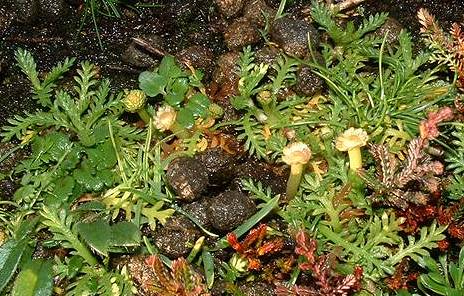
| Back to the Annual Report Contents and Home page |
Towards the end of November last year, Tom and I were up near the trig point (at a height of 1200 ft) on Rudland Rigg. The area is called “Golden Heights” on our OS map, probably because of the colour of the sandy road. We were birding, mainly hoping to see hen harriers, and set out across the moor to look into Bransdale, when we spotted a small plant. It caught our attention because it was very green and in flower in November, and on closer study we realised we had not seen anything like it before. Back at home we checked our books, and in spite of having attended the Ryenats botany workshop, could find nothing resembling the plant we had found. We hadn’t had the camera with us, so the following day Tom rode up to the trig point on his bike and took some photos which we sent to Gill and Nan (fully expecting them to come back to us quite quickly with an identification).
However, our description and photo were not sufficient for them to name the plant and there was also some confusion as to location because Tom had misread his GPS and got his easts and wests mixed up, which placed the plant a short distance out to sea, off Scarborough!

A couple of weeks later Nan found time to come and have a look for herself and the first thing she noticed was many more plants than we had realised were there, all along the side of the road and down into a drainage ditch. Nan and her accompanying botanist friends were unsure of the identification but suspected it was an ‘incomer’ from New Zealand which in normal circumstances would grow considerably taller than the plants we had found. [Ed: It is a composite from the daisy family, and seems to thrive in bare, stony places. The leaves are divided, almost feathery, a little like yarrow.]
The plant, Cotula squalida, also known as Leptinella squalida is indeed from New Zealand, and is known to have invaded other parts of Britain, but this is the first sighting in our part of Yorkshire. The mystery, probably never to be solved, is how it came to be growing high up on our moors. [Ed: it has since been pointed out to me that our plant is in fact the closely related Cotula alpina; thanks to Phyl Abbott and Linda Robinson from the West Riding.]
Back to the Annual Report Contents and Home page
Text copyright © Ryedale Natural History Society 2006, 2010 Site maintained by APL-385